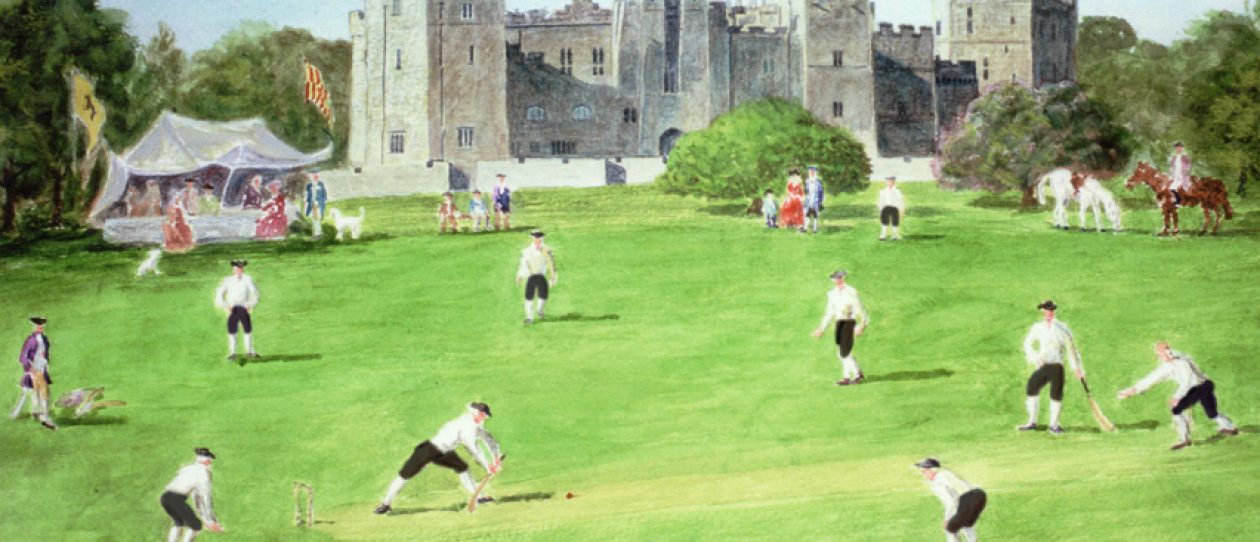Transport developments had considerable influence upon cricket. More profound than simply enabling teams travel farther afield. With every improvement in transport and communications cricket grew more skilful, more diverse, better organised. It is no coincidence that one of the fastest growth periods was during the fifty years following the opening of the Stockton-Darlington railway in 1825. The High Level railway bridge spanned the River Tyne twenty-five years later so, in 1856, mighty Stockton could pursue their glorious odyssey as far north as Edinburgh.
The gentry of 1751 had a bumpy ride in post-chaises when travelling the seven country miles between Stanwick and Raby Castle. The Great North Road, recently-turnpiked, was “broken into holes like an old pavement; sufficient to dislocate one’s bones.” Common folk used ‘shank’s pony’, the oldest form of transport of all. Joseph Eltringham remembered walking from Consett to Hexham and back for a match in the 1880s. Cricket gear had to be carried, too, although Stockton’s accounts for 1880 show the cost of cabs to transport the gear to and from the station.
Nineteenth century transport was horse-drawn. Clubs travelled in two or more traps, mining sides used colliery wagons. Durham City took three-and-a-half hours to reach Norton in 1834. They left at 6am, began playing at 11 and got home at midnight. When Darlington went to Constable Burton in 1869 they “escaped from business and its cares, and were exhilarated by a 20-mile ride behind four horses. The party were charmed by the beauties of the scenery and had a happy day of it.” Eppleton Church’s return from Penshaw in 1894 was less serene. The horses took fright and their brake overturned outside the “Swan Inn” at Shiney Row causing nasty injuries. Young lads accompanied Crook Wednesday to Staindrop. “Finding the inside vehicle filled with eleven players, the boys climbed to the top of the coach.” As the coach rattled homeward, young Coulthard grabbed an overhanging tree branch and was catapulted to earth. His friends raced back to his limp body but there was nothing they could do. He died the following day.
Third-class travel was available in certain areas some fifteen years after the opening of the Stockton-Darlington railway. As the rail system spread, composition of leagues was part-determined by the nearness of clubs to the railway line. Rail travel enabled clubs travel further afield but caused problems for Bishop Auckland. A match in 1892 was delayed while they waited for Huddersfield-based pro George Hirst and George Tyndale who “lost a train at Leeds”. Bishop Auckland eventually cited inconveniently long rail routes and bad connections as reasons for not entering a league. They joined NYSD but had to forfeit a match in 1909 because they had to catch the last train or spend the week-end in Guisborough. It even cost them a share of the title in 1919. They were denied certain victory when two hours’ play was lost because Guisborough’s train was held up at Darlington station.
Swalwell experienced all manner of trouble at Consett in 1908. They were not only dismissed for 32 but then the home side replied with 353 for 7. Swalwell reached Blackhill station in good time for the last train at 9.26 pm. Six went for a stroll, probably to slake their thirst after a gruelling day. They returned to find the train in the station but the platform gate was locked. Station staff were deaf to their frantic shouts. They walked the 12 miles to Swalwell, arriving at two in the morning. They travelled by brake for their next away match. This time they were late for the start because a horse cast a shoe and it took an hour to find a blacksmith to have the horse re-shod.
For the 1926 inter-league match between DSL and NYSD arrangements were made for the Sunderland-Middlesbrough express to stop to pick up players and spectators at one or two intervening stations. Consett’s followers travelled to South Moor in such large numbers in 1911 that a ‘relief’ train was added. Others cycled or used pony and trap and hundreds tramped over fields via Charley Pit. Coastal clubs were reached by boat. Hinderwell sailed to Jarrow from the Grinkles, near Whitby, for a match at Wardley Colliery in 1876. The venture extended over two days. ‘I Gingeriferi’ set sail to coastal grounds in 1875. They anchored three days at Seaton Carew and after the match their captain carried his unfurled flag down to the beach. “The last that was heard of the Gingeriferi was a parting solo by Jamieson on his horn across the waters.”
Motorised-buses began to replace horse-buses in the early 1900s. After the war toffs like Joseph Eltringham owned a motor car giving him the advantage of being able to return to Consett to pick up a player when one short at Medomsley. Consett’s Jack Wheatley travelled by motor-cycle with George Hurst on pillion. Increased mobility enabled clubs to arrange cricket tours. South Shields toured the Scottish Borders in 1878. West Hartlepool went to the Fens in 1896 and played a match at Old Trafford during a tour of Lancashire in 1901. Yorkshire provided a convenient, popular itinerary. More prosperous clubs toured the Home Counties, Kent and the Cotswolds and Reyrolle organised annual trips to Northern Ireland.
Petrol shortages created difficulties during the Second World War after which public transport disputes caused matches to be cancelled. Punctuality and reliability are obvious benefits of travelling by car although four Kimblesworth men were injured in a crash in 1978. It happened on the outskirts of Durham, ironically near White Smocks, the uniform that tended upon them at Dryburn Hospital. Car dependency may present future difficulties for cricketers if roads become so congested that measures are taken to curb its use.
